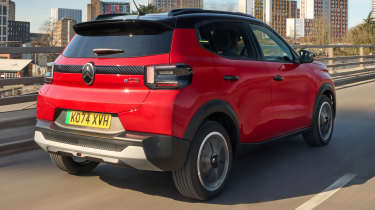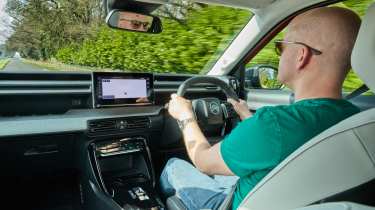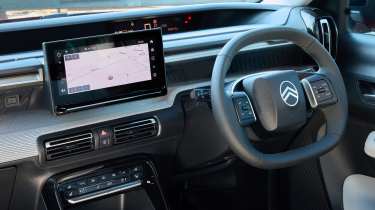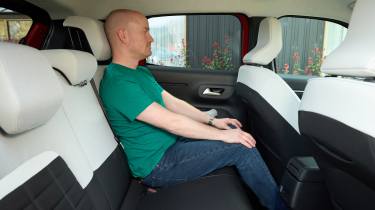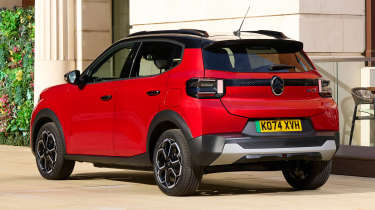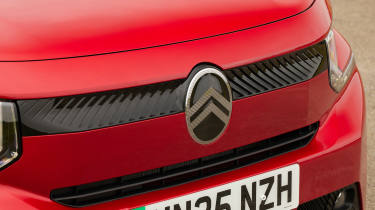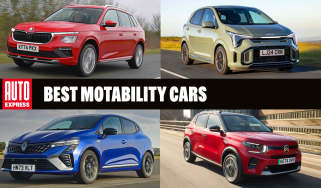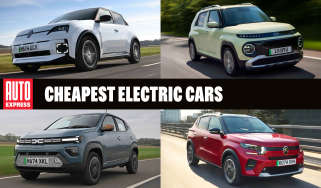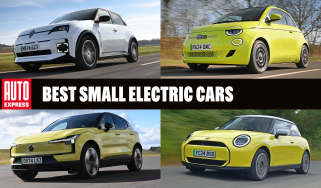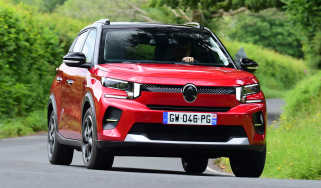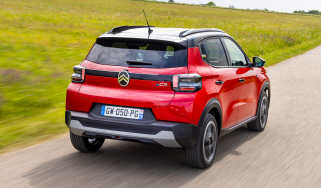Citroen e-C3 review
The Citroen e-C3 is a cheap French supermini and exactly the sort of small electric car we’ve been waiting for

Our opinion on the Citroen e-C3
We’ve always felt that electric car technology would make the most sense powering small, affordable and clean transport. Following an initial diversion via some large, very expensive SUVs, it seems like the industry - and particularly Citroen - has finally landed on the ideal formula.
It’s not only the price point of the Citroen e-C3 that appeals. Citroen has produced a supermini with class-leading comfort and plenty of space, all while creating a car that doesn’t feel like it’s compromised by its low price point. The e-C3 really is a benchmark for the rest to aim for.
About the Citroen e-C3
It’s easy to make a big car profitable. When you’re asking six figures for a car, prospective buyers aren’t going to bat an eyelid at the prospect of the extra few grand needed to clear a manufacturer's margins. It’s much tougher when it comes to small cars, just ask Ford and all of the other brands that have gradually backed away from making superminis in recent years.
That squeeze becomes even tougher when shoehorning electric powertrains into a small car, because they (in particular, the battery packs) are still more expensive than petrol or diesel engines. However, price parity grows ever nearer, and the Citroen e-C3 is one car that capitalises on this in spectacular style.
Used - available now
While base petrol versions of the fourth-generation C3 are still cheaper, the e-C3 is still so competitively priced that it costs much the same as many petrol-powered rival superminis.
Citroen has kept the line-up very simple, with just two trim levels, Plus and Max, along with two powertrains.
Citroen e-C3 prices and latest deals
Starting at a shade under £20,000, the Citroen e-C3 is already competitively priced, but it then gets a further £1,500 lopped off the price thanks to the Government’s Electric Car Grant.
If you’d like to spend even less, you can save an average of £3,800 when you configure your ideal Citroen e-C3 via the Auto Express Buy a Car service. You can also find the very latest Citroen e-C3 leasing deals or search for a used Citroen e-C3. You can even sell your existing car for a great price with Auto Express Buy My Car.
Performance & driving experience
Pros |
|
Cons |
|
Citroen has done an amazing job in keeping the e-C3's price down to the level of many petrol-powered superminis, and the powertrain plays a big part in this. While loads of other electric car makers go for power outputs that often seem a bit much for a sensible everyday vehicle, Citroen has instead made sure that its e-C3 provides the sort of figures you’d get from an internal combustion-powered small car. As a result, there’s a single motor up front, and it makes 111bhp and 120Nm of torque regardless of your chosen spec.
| Model | Power | 0-62mph | Top speed |
| e-C3 Max 44kWh | 113bhp | 10.4 seconds | 82mph |
| e-C3 83kW Plus 44kWh | 113bhp | 10.4 seconds | 82mph |
| e-C3 83kW Urban Range Plus 30kWh | 113bhp | 10.4 seconds | 82mph |
Performance, 0-60mph acceleration and top speed
Those stats are enough to get the Citroen e-C3 from 0-62mph in an unremarkable, but perfectly acceptable, 10.4 seconds. Top speed is 82mph.
In reality, the e-C3 feels a bit more lively than an equivalent petrol or diesel car that’s capable of those numbers. Although its electric motor doesn’t deliver anything like the sort of punch we’ve grown used to with many EVs, it still responds more keenly than a traditional engine. That’s even more so because the maximum output of the motor is available at any road speed, and there are no gears to worry about here. The motor emits a little whine under hard acceleration, but it’s not too intrusive or unpleasant.
Regenerative braking helps to add some charge back into the battery when slowing down, and the first portion of the brake pedal’s travel decelerates the car using the electric motor rather than the mechanical brakes. Lifting off gives only a slight level of regen, while pressing the ‘C’ button beside the gear selector increases the level of deceleration, but not by very much.
Town driving, visibility and parking
One of the first things that springs to mind when we think of Citroens is pillowy soft ride comfort, and that’s certainly the case with the e-C3. The brand’s Advanced Comfort tech makes use of the hydraulic bump stops already fitted to many Citroens; these help to reduce the shock at the top of the car’s suspension travel, enabling the primary springs and dampers to be tuned for a softer response without unduly compromising body control. Around town, this means that the e-C3's ride is very forgiving, soaking up imperfections that would jostle and rattle many of its competitors.
The high driving position makes it easy to see out - especially from the front seats - and light steering makes it easy to twirl the wheel as you move in and out of tight spots. Both trim levels get rear parking sensors as standard, while the top-spec Max trim gets a reversing camera, too.
Country road driving and handling
With that soft ride, however, it’s fair to say that keen handling isn’t high up the e-C3’s list of priorities. The Renault 5 is a more enjoyable small EV to drive, but given the Citroën's relatively low weight by EV standards, plus body roll that is kept fairly well in check, it’s more competent around the corners than the pillowy suspension would have you believe at first.
If anything, it’s the steering that lets the side down the most. With so little feedback, it’s a car that you tend to relax into purely because it’s hard to know what the front tyres are up to. It may seem a little fussy to make such a complaint in a car like this, but other small EVs like the Renault 5 have proven that decent ride comfort and an enjoyable drive don’t have to be mutually exclusive.
Motorway driving and long-distance comfort
The Citroen’s fairly bluff front end tends to generate quite a bit of wind noise once it reaches motorway speeds. The ride comfort remains fairly soothing at higher speeds, but the light steering of the e-C3 means it doesn’t feel as settled or as planted as a Renault 5 when cruising.
“It’s really refreshing to drive a modern car that doesn’t pretend to be sporty. The e-C3 is unashamedly about delivering comfort, and nails it. I hope that more everyday cars will follow its lead.” - Alex Ingram, chief reviewer.
Range, charging & running costs
Pros |
|
Cons |
|
The e-C3 is best suited to urban driving, although there’s enough range for occasional motorway trips if you opt for the 44kWh model. This larger battery is still modestly sized compared with many electric cars, but its 201-mile WLTP range should prove enough for the overwhelming majority of users. If you’re someone who only makes shorter journeys and would like to save a couple of thousand pounds, the entry-level 30kWh battery claims up to 130 miles on the same cycle.
The way that you drive the car will have a large influence on the overall range and efficiency. During our test of the 44kWh car, with a large proportion of driving on 70mph motorways, we achieved 3.5 miles/kWh, which works out at 153 miles of real-world range. This means that the e-C3’s range comes close to matching the 3.9miles/kWh we achieved in the Renault 5 when driving in similar conditions, although that car uses a slightly larger battery, giving it better overall range.
However, keep off the motorways and on a route with speeds mostly below 50mph, and that figure climbs up to roughly 5.0mi/kWh, boosting the range to around 220 miles. These numbers were achieved at temperatures of 13 degrees Celsius. As with many EVs, this number will drop in colder winter weather.
When you need to top up, the smaller 30kWh battery pack manages rapid charging speeds of up to 30kW, which allows for a 20 to 80 per cent top up in 36 minutes. The larger 44kWh unit bumps this speed up to 100kW, with a 20-80 per cent top-up taking 26 minutes. Utilise a 7.4kW home wallbox charger, and it should take around five hours to recharge the 30kW version, and seven hours to fully recharge the 44kW model from flat.
However, during our electric car charging mega test, the 44kWh Citroen e-C3 only held a speed of 100kW for three minutes. After reaching this peak, the rate quickly declined, and we ended up waiting 10 minutes longer for a 20 to 80 per cent charge than the brand claims.
| Model | Battery size | Range | Insurance group |
| e-C3 Max 44kWh | 44kWh | 201 miles | 24 |
| e-C3 83kW Plus 44kWh | 44kWh | 201 miles | 24 |
| e-C3 83kW Urban Range Plus 30kWh | 30kWh | 130 miles | 24 |
Insurance groups
As it stands, both the Plus and Max versions of the e-C3 sit in group 24. That’s a little higher than the Renault 5, which ranges from 20 to 22. This Citroen’s sister car, the Fiat Grande Panda Electric, resides in groups 23 and 24.
Tax
Thanks to the Citroen’s Benefit-in-Kind tax banding of just 3 per cent, as well as its low purchase price, very few cars on sale today are as cheap to run for company car users. However, EVs no longer qualify for zero VED road tax, so you will have to pay the standard annual fee.
Depreciation
Our expert data suggests that the Citroen e-C3 is set to depreciate a little more than some rivals.
After three years or 36,000 miles, it’s expected to hold onto between 42 to 44 per cent of its original value; that’s about the same as a BYD Dolphin Surf, but the all-electric Renault 5 is predicted to hold onto roughly half of its value over the same period.
To get an accurate valuation on a specific model check out our free car valuation tool...
Interior, design & technology
Pros |
|
Cons |
|
The e-C3 was the first car in Citroen's line-up to follow the brand’s latest design direction, first previewed by the wacky Oli concept in 2022. And while the e-C3 has clearly toned down the show car’s look, smaller details, such as the three-piece headlight units, are very familiar.
The car’s overall boxy shape lends itself well to these chunky details, though we do feel that Fiat’s Grande Panda, which uses the same Smart Car platform, does a better job of making this basic shape look more distinctive.
Interior and dashboard design
Inside, the e-C3 looks fairly distinctive for a small, affordable car. White highlights - and with Max trim, lightly coloured panels on the seats - lighten up the cabin.
The most interesting aspect takes a leaf out of sister French brand Peugeot’s book, combining a compact steering wheel with a digital instrument panel, which is designed to be viewed from above the top of the wheel rim, rather than through it.
While this set-up in Peugeot cars often divides opinion among the Auto Express test team (in many cases the wheel obstructs the view of the driving information), we think the e-C3’s mix of a high driving position and a slim digital readout means that the system works well and without any visibility issues.
Citroen has kept physical controls for the air-conditioning, and these take the form of chunky rotary dials in the Plus trim, and big buttons on the Max.
Materials and build quality
The curved dash design incorporates a shelf on the passenger side, and this area is trimmed in a woven fabric material that does a great job of making the cabin look interesting. It also brings the added bonus that it doesn’t feel as cheap as you might imagine, given the interior is finished entirely in hard plastic.
Infotainment, sat-nav and stereo
The e-C3’s infotainment set-up is fairly basic, which on the plus side, means that it isn’t too difficult to get to grips with. All models get the same 10.25-inch touchscreen, but built-in satellite navigation is only fitted to the higher-ranking Max trim.
A row of shortcut keys sits along the right-hand side of the screen, making it easy to move from one function to the next, and loading times are reasonable if not outstanding. The system in the Renault 5 is sharper to look at, quicker to load and feels much more slick, though.
“Not only does it look much more modern and aggressive, but the build quality is light years ahead. In fact, that’s one of the most appealing things about the e-C3: this is essentially a budget small car, but thanks to clever design inside and out, it feels anything but low-rent.” - Alastair Crooks, senior news reporter.
Boot space & practicality
Pros |
|
Cons |
|
Practicality is always a fine balancing act in a supermini. The smaller the car is on the outside, the better it’ll be at squeezing through tight gaps in the city and slotting into small parking spaces, but that will come at the expense of interior space.
The Citroën e-C3 is about average for the supermini class in terms of length, but it’s taller than most. As a result, it’s impressively spacious for a car with such a modest footprint, with the boxy five-door shape adept at accommodating five people.
Dimensions and size
At a smidge over four metres long, the e-C3 is over 100mm shorter than the Skoda Fabia, but Citroen has managed to extract its interior space by building upwards; at 1,813mm, the e-C3 is taller than the Fabia.
| Dimensions comparison | |||
| Model | Citroen e-C3 | Renault 5 | Skoda Fabia |
| Length | 4,015mm | 3,922mm | 4,137mm |
| Width | 1,813mm | 1,774mm | 1,780mm |
| Height | 1,577mm | 1,498mm | 1,482mm |
| Wheelbase | 2,540mm | 2,495mm | 2,560mm |
| Boot space | 310 to 1,188 litres | 277 to 959 litres | 380 to 1,190 litres |
Seats & passenger space
Citroen says that the e-C3’s driving position is roughly 100mm higher than in the average supermini. Not only does this help with the view of the road ahead, but it’s also a benefit to those who find getting in and out of some other small cars a little tricky.
Once you’re settled in, the Advanced Comfort seats feel more supportive than those in earlier Citroens - more side bolstering has been added to hold the front occupants in place a little better - and there’s a decent range of adjustment for both the driver’s seat and the steering wheel, which adjusts both in and out, and up and down.
As in the front, the tall bodystyle pays dividends for rear-seat passengers, with tall doors that make it easy to get in and out. A cut-out in the back of the e-C3’s roof area means that even adults of well over six feet tall can settle into the rear without brushing their heads against the lining.
There’s a little less wiggle room when it comes to knee space - this is a short car after all, but overall space is up with the very best in the class.
Boot space
At 310 litres, the e-C3’s boot is larger than the Renault 5’s 277 litre area, but a little down on what you’ll get in the most spacious petrol-powered superminis such as the Fabia.
The opening isn’t quite as wide as the barn-like rear door suggests, but it is tall, so it’s possible to make use of the 1,188 litre volume when the 60:40-split rear seat is folded down.
“Compared to the other extremely talented electric supermini of the moment, the Renault 5, it’s the Citroen e-C3 that’s by far the more practical of the pair” - Alex Ingram, chief reviewer.
Reliability & safety
Pros |
|
Cons |
|
Front, side, and curtain airbags front and rear are all standard fit on the e-C3, though the car hasn’t currently been tested by Euro NCAP.
The e-C3 is yet to appear in the Driver Power customer satisfaction survey. A number of the French brand’s cars did score well in the most recent best car to own leaderboard, but it only managed 16th place out of 31 brands in the best manufacturer results.
Buying and owning
- Best buy: Citroen e-C3 Plus 44kWh
While it’s a few thousand pounds more than the entry-level Urban Range car, investing in the larger battery opens up the e-C3’s potential as more than just a runaround. That being said, if you’re 100% set on only using it for short distances, the 30kWh battery should suffice.
While both trim levels are competitively priced, we’d save the pennies here and opt for the entry-level Plus trim. The Max gets some extra features, but while a reversing camera and wireless smartphone would be nice to have, most of the additional kit simply isn’t essential.
Citroen e-C3 alternatives
If comfort is your top priority, the most viable alternative to the Citroen comes with a petrol engine. The Skoda Fabia is an excellent all-round supermini, but it’s a little more expensive than some other internal-combustion cars; even beside the electric Citroën, it feels like you’ll need to bag a great deal to make it feel like strong value.
In terms of electric alternatives, the closest competition comes from the Renault 5. Brilliantly stylish with fabulous in-car tech, strong performance and fine driving dynamics, the 5 is strong in plenty of areas that aren’t a priority for the e-C3. Conversely, the Citroen is far more practical, more comfortable and a little cheaper than its French rival. On top of this, there’s Citroen’s own sibling to consider. The Fiat Grande Panda adds a bit of typical Italian style to the e-C3’s shared platform, and it carries a similarly attractive price.
Deals on the Citroen e-C3 and alternatives
Frequently Asked Questions
Citroen’s standard warranty lasts for three years, but this can be extended to eight years or 100,000 miles with Citroen’s ‘WeCare’ cover. This is applied when your car’s routine servicing is carried out by an authorised Citroen workshop.




